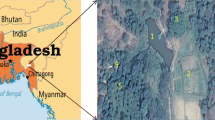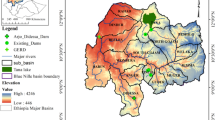Abstract
Small reservoirs have proved as successful rainwater harvesting systems in semi-arid regions; however, their dependability in arid regions is not tested. This study aimed at evaluating cost-effectiveness of small reservoir used for supplying irrigation water to wheat and mustard crops in an arid region of India by employing three performance indicators, i.e., benefit-cost (B-C) ratio, net present value (NPV) and internal rate of return (IRR). In addition, sensitivity analysis of the variables influencing the economics of the reservoirs is also carried out. The actual water requirements for wheat and mustard crops over their entire life span of 110 and 95 days, respectively, are computed as 319 and 227 mm, respectively, in comparison to existing practice of excessively irrigating the crops. Fixed cost, i.e., cost of construction of the reservoir is estimated as Rs. 1,033,349, for a total storage capacity of 29,184.5 m3, whereas, the running cost, i.e., cost of cultivation for wheat and mustard, is worked out to be Rs. 41,800 and 31,100 per ha, respectively. The net benefit of Rs. 28,901 and 38,835 per ha, respectively for wheat and mustard crops clearly indicated that mustard is 34% economical over the wheat. The optimistic, pessimistic, and average unit costs of harvested rainwater over a 30-year period is calculated as Rs. 1.51, 3.03, and 2.27 m−3, respectively, which suggests that a small reservoir is a viable option for rainwater management in the arid regions. This finding is further supported from the optimum values of B-C ratio (1.01), NPV (Rs. 10,093), and IRR (10.12%). This study considered a scenario of demand-based efficient irrigation supplies with improved values of the B-C ratio (2.18), NPV (Rs. 1,330,558), and IRR (24%). Furthermore, sensitivity analysis revealed that the grain yield is the most significant variable affecting the cost-effectiveness of the reservoir system, which needs to be carefully monitored and enhanced in order to further increase reservoir dependability in arid regions. Finally, the findings of this study are very useful for planners and decision-makers to formulate appropriate strategies for managing scarce rainwater in the study area as well as in other arid climate regions of the world.





Similar content being viewed by others
References
Allen, R.G., Pereira, L.S., Raes, D., Smith, M. (1998). Crop evapotranspiration – guidelines for computing crop water requirements. FAO irrigation and drainage paper 56. Food and Agriculture Organization (FAO), Rome, 174 pp
Annor FO, van de Giesen N, Liebe J, van de Zaag P, Tilmant A, Odai SN (2009) Delineation of small reservoirs using radar imagery in a semi-arid environment: a case study in the upper east region of Ghana. Phys Chem Earth 34:309–315
Antonino ACD, Hammecker C, Montenegro SMLG, Netto AM, Angulo-Jaramillo R, Lira CABO (2005) Subirrigation of land bordering small reservoirs in the semi-arid region in the Northeast of Brazil: monitoring and water balance. Agric Water Manag 73:131–147. https://doi.org/10.1016/j.agwat.2004.10.001
Boers TM, Ben-Asher J (1982) A review of rainwater harvesting. Agric Water Manag 5:145–158. https://doi.org/10.1016/0378-3774(82)90003-8
Brooks KN, Ffolliott PF, Gregersen HM, DeBano LF (1998) Hydrology and the Management of Watersheds. Panima Publishing Corporation, New Delhi 502 pp
Bruins HJ, Evenari M, Nessler U (1986) Rainwater-harvesting agriculture for food production in arid zones: the challenge of the African famine. Appl Geogr 6:13–32. https://doi.org/10.1016/0143-6228(86)90026-3
Da Silva, A.C.S., De Silans, A.M.P., Da Silva, G.S., Santos, F.A.D., Porto, R.D.Q. and Neves, C.A. (2011). Small farm dams research project in the semi-arid northeastern region of Brazil. Risk in Water Resources Management, Proceedings of Symposium H03 held during IUGG2011 in Melbourne, Australia, July 2011. IAHS Publication No. 347, pp. 241-246
Downing JA, Prairie YT, Cole JJ, Duarte CM, Tranvik LJ, Striegl RG, McDowell WH, Kortelainen P, Caraco NF, Melack JM, Middelburg JJ (2006) The global abundance and size distribution of lakes, ponds, and impoundments. Limnol Oceanogr 51(5):2388–2397. https://doi.org/10.4319/lo.2006.51.5.2388
Fraiture CD, Wichelns D, Rockström J, Benedict EK (2007) Looking ahead to 2050: scenarios of alternative investment approaches. In: Molden D (ed) Water for food – water for life. A comprehensive assessment of water Management in Agriculture. Earthscan, London and International Water Management Institute, Colombo, pp. 91-145
Gittinger JP (1982) Economic analysis of agricultural project. EDI series in economic development, WB. Johns Hopkins University Press, Baltimore. https://doi.org/10.1016/0039-6257(82)90112-6
Güntner A, Krol MS, Carlos De Araújo J, Bronstert A (2004) Simple water balance modelling of surface reservoir systems in a large data-scarce semiarid region. Hydrol Sci J 49(5):901–918
India Water Portal (2009). Meteorological datasets: download entire datasets for various meteorological indicators from 1901 to 2002. http://www.indiawaterportal.org/met_data/ (accessed on 23 December 2014)
Kahinda JM, Lillie ESB, Taigbenu AE, Taute M, Boroto RJ (2008) Developing suitability maps for rainwater harvesting in South Africa. Phys Chem Earth 33(8–13):788–799
Kavarana G (2006) The value of a raindrop. Traditional RWH systems, particularly in the arid and semiarid regions of Rajasthan and Gujarat. In: Edmunds, W.M. and Cardona, C. (editors) Final Report of UNESCO G-WADI meeting on water harvesting, Aleppo, Syria, 20-22 November 2006, p. 49-57
Krol, M.S., de Vries, M.J., van Oel, P.R. and Carlos de Araújo, J. (2010). Effects of small reservoirs on large scale water availability. In: Swayne, D.A., Yang, W., Voinov, A.A., Rizzoli, A. and Filatova, T. (Editors), Proceedings of the International Congress on Environmental Modelling and Software, Canada. http://www.iemss.org/iemss2010/index.php?n=Main.Proceedings (accessed on 6-9-2016)
Kunze D (2000) Economic assessment of water harvesting techniques: a demonstration of various methods. Q J Int Agric 39(1):69–91
Li Q, Gowing J (2005) A daily water balance model approach for simulating performance of tank-based irrigation systems. Water Resour Manag 19:211–231. https://doi.org/10.1007/s11269-005-2702-9
Liebe J, van de Giesen N, Andreini M (2005) Estimation of small reservoir storage capacities in a semi-arid environment: a case study in the Upper East Region of Ghana. Phys Chem Earth 30:448–454
Liebe JR, van de Giesen N, Andreini M, Walter MT, Steenhuis TS (2009) Determining watershed response in data poor environments with remotely sensed small reservoirs as runoff gauges. Water Resour Res 45:W07410. https://doi.org/10.1029/2008WR007369
Machiwal D, Jha MK, Singh PK, Mahnot SC, Gupta A (2004) Planning and design of cost-effective water harvesting structures for efficient utilization of scarce water resources in semi-arid regions of Rajasthan, India. Water Resour Manag 18(3):219–235. https://doi.org/10.1023/B:WARM.0000043152.86425.7b
Machiwal D, Dayal D, Kumar S (2015) Assessment of reservoir sedimentation in arid region watershed of Gujarat. J Agric Eng 52(4):40–49
Machiwal D, Kumar S, Dayal D, Mangalassery S (2016a) Identifying abrupt changes and detecting gradual trends of annual rainfall in an Indian arid region under heightened rainfall rise regime. Int J Climatol 37(5):2719–2733
Machiwal D, Dayal D, Kumar S (2016b) Need of soil and water conservation measures in arid Kachchh District of Gujarat. In: Dayal D, Machiwal D, Mangalassery S, Tripathi RS (eds) Improving productivity of drylands by sustainable resource utilization and management. New India Publishing Agency, New Delhi, pp 83–96
Machiwal D, Dayal D, Kumar S (2017) Estimating water balance of small reservoirs in arid regions: a case study from Kachchh, India. Agric Res 6(1):57–65. https://doi.org/10.1007/s40003-016-0243-5
Machiwal D, Gupta A, Jha MK, Kamble T (2018) Analysis of trend in temperature and rainfall time series of an Indian arid region: comparative evaluation of salient techniques. Theor Appl Climatol. https://doi.org/10.1007/s00704-018-2487-4
Malveira VTC, de Arujo JC, Guntner A (2011) Hydrological impact of a high-density reservoir network in semiarid Northeastern Brazil. J Hydrol Eng ASCE 17:109–117
Meigh J (1995) The impact of small farm reservoirs on urban water supplies in Botswana. Nat Res Forum 19(1):71–83. https://doi.org/10.1111/j.1477-8947.1995.tb00594.x
Mushtaq S, Dawe D, Hafeez M (2007) Economic evaluation of small multi-purpose ponds in the Zhanghe irrigation system, China. Agric Water Manag 91:61–70. https://doi.org/10.1016/j.agwat.2007.04.006
Ngigi SN (2003) What is the limit of up-scaling rainwater harvesting in a river basin? Phys Chem Earth 28(20–27):943–956
Papa MN, Mitidieri F, Amitrano D, Ruello G, Martino GD, Iodice A, Riccio D (2016) Monitoring small reservoirs in semi-arid region by satellite SAR data. Geophys Res Abstr 18:EGU2016–EG16436
Prusty BAK (2012) Ambient air quality surveillance and indexing in and around mining clusters in western Kachchh region, Gujarat, India. Open J Air Pollut 1:22–30
Rao JD, Trivedi SA (2012) Managing irrigation canal system with optimum irrigation scheduling for watrak irrigation scheme of north Gujarat, India. J Engg Res Studies 3(2):25–27
Raut S, Sarma KSS, Das DK (2010) Study of irrigation and crop water requirements and growth of two rabi crops grown in a semi arid region using agrometeorology and remote sensing. J Indian Soc Remote Sens 38:321–331. https://doi.org/10.1007/s12524-010-0021-y
Revadekar JV, Preethi B (2010) Statistical analysis of the relationship between summer monsoon precipitation extremes and food grain yield over India. Int J Climatol 32(3):419–429
Rockström JM, Karlberg L, Wani SP, Barron J, Hatibu N, Oweis T, Bruggeman A, Farahani J, Qiang Z (2010) Managing water in rainfed agriculture—the need for a paradigm shift. Agric Water Manag 97:543–550. https://doi.org/10.1016/j.agwat.2009.09.009
Singh S, Kar A (1996) Integrated natural and human resources appraisal for sustainable development of Kachchh District. Report of Central Arid Zone Research Institute (CAZRI), Jodhpur
United Nations (2015). World Population Prospects: The 2015 Revision. Department of Economic and Social Affairs, Population Division, United Nations. https://esa.un.org/unpd/wpp/ (accessed on 6–9-2016), DOI: https://doi.org/10.1055/s-0035-1549280
Wisser D, Frolking S, Douglas EM, Fekete BM, Schumann AH, Vörösmarty CJ (2010) The significance of local water resources captured in small reservoirs for crop production – a global-scale analysis. J Hydrol 384:264–275. https://doi.org/10.1016/j.jhydrol.2009.07.032
XE (2002). Universal currency converter. Xenon Laboratories Incorporated. https://www.xe.com/currencyconverter/ (accessed on 26 September 2016)
Yuan T, Fengmin L, Puhai L (2003) Economic analysis of rainwater harvesting and irrigation methods, with an example from China. Agric Water Manag 60:217–226. https://doi.org/10.1016/S0378-3774(02)00171-3
Critchley WRS, Reij C, Willcocks TJ (1994) Indigenous soil and water conservation: a review of the state of knowledge and prospects for building on traditions. Land Degrad Rehabil 5:293–314
Pisharoty PR (1990) Characteristics of Indian rainfall. Monograph, Physical Research Laboratories, Ahmedabad, Gujarat, India
Acknowledgements
Authors gratefully acknowledge the support and necessary facilities provided by the Director, ICAR-Central Arid Zone Research Institute (CAZRI), Jodhpur for carrying out this study. They also wish to thank anonymous reviewers whose valuable comments helped improving earlier version of this manuscript.
Author information
Authors and Affiliations
Corresponding author
Rights and permissions
About this article
Cite this article
Machiwal, D., Kumar, S. & Dayal, D. Evaluating Cost-Effectiveness of Rainwater Harvesting for Irrigation in Arid Climate of Gujarat, India. Water Conserv Sci Eng 3, 289–303 (2018). https://doi.org/10.1007/s41101-018-0058-2
Received:
Revised:
Accepted:
Published:
Issue Date:
DOI: https://doi.org/10.1007/s41101-018-0058-2




